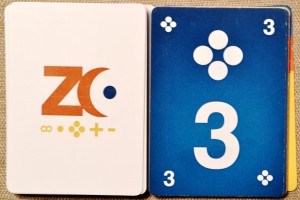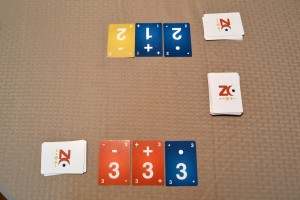You’d think that a card deck from another planet would be difficult to understand and play, but as I’ve come to learn with “The Zont Deck”, that simply isn’t the case. Like other Kickstarter projects I’ve covered, “The Zont Deck” is more than just a game…it’s a template that allows for folks to make use of multiple variants. Before we get started, I’d like to thank game creator Kevin Omans from Zontco LLC for reaching out and providing me with a press copy. As with all prototypes, it’s important to stress that they are usually not representative of the final product. In this case, the card art and gameplay mechanics are final, but the box art and instruction manual may or may not undergo some changes. There’s also the possibility that more variants will be added to the manual in the future, though nothing is set in stone.
There aren’t that many components to keep track of as the product itself comes with fifty-five unique playing cards. The manual may appear to be lengthy (the PDF is twenty pages long), but the text is large and the gameplay mechanics are explained clearly. I can vouch that you won’t have a difficult time understanding the three game variants that are listed there…the real learning curve is understand the suits associated with the cards and what they do. Unlike the four suits found in a standard deck of cards, “The Zont Deck” comes with a total of five different suits that each do something special when played. I highly recommend getting a handle on these suits first before attempting to learn one of the game variants.
I know that sounds like a lot, but it’s really not. The “Art” suit (represented by the plus symbol), signifies gain. Players who play an “Art” card have the ability to do things like draw a new card or play an extra card. “Change” (represented by the minus symbol), signifies loss. This suit allows players to destroy a card or force others to discard. “The Great Zont” (represented by a dot), unlike the others, doesn’t have a special action. However, it is immune to other card effects. “Favors” (represented by four dots) are global effect cards that change the gameplay as whole in some way. Finally, “Giglets” (represented by the infinity symbol) are wild cards of sorts, taking on the power of a card that it’s on top of or next to.
As I mentioned above, the manual includes a total of three variants or games: “Ten”, “Key”, and “Bazaar”. “Ten” and “Bazaar” are for two or three players, while “Key” allows up to four. All of them can be played in about a half hour, sometimes less. “Ten” is probably the easiest of the three, so I highly recommend checking out this variant first, at least until you get comfortable with the suits and how they act. It’s important to note however that the suit powers DO change slightly from game to game, but the differences don’t require that big of a crunch in terms of a learning curve. Having played “Ten” with the kids, I can safely vouch for the ease of play, even with regard to the younger twelve-year-old.
“Ten”, just to put things in perspective, involves the scoring of cards in order to earn the most points. At the start of the game, each player will receive five cards to form their hand. On a player’s turn, they’ll play one card in front of them to form or continue a horizontal line of cards from left to right. As mentioned above, suit powers are observed as these cards are played. Once the effect has been completed, the player will draw back up to five cards with play continuing clockwise to the next person. When the cards in front of a particular player value ten or more, they’ll pick them up and place them into their score pile (called a “clear”). Play continues until the deck runs out and there are no more cards in players’ hands. The score piles are totaled (the cards still on the horizontal line don’t count) and whoever has the most, wins the game!
As you can see from the above, “Ten” is incredibly easy to play and can be knocked out in as little as fifteen minutes if players put their minds to it. The same can be said for the other two games in that play time can be lessened as folks gain experience and get used to the suit effects. “Key” is probably my favorite of the three and I highly recommend giving it a go once you get a handle on the deck itself. As such, “The Zont Deck” as a whole is great for nights were you don’t have a lot of time to play a larger, more complex board game. The small size makes it ideal for travel as well, whether it be vacations or a simple visit to a friend’s house. I’d be lying if I said that there wasn’t a little bit of strategy involved too, as the suits you play will have a direct impact on you and other players. Variants like “Key” promote strategy all the more, since players in that game will be manipulating suit piles in order to affect their final score.
All in all, “The Zont Deck” is a great mix of casual fun and strategic play. This is one card game you won’t want to shy away from, even if it did come from another planet.
—
You can learn more about and support “The Zont Deck” by visiting its Kickstarter campaign, here:
http://www.kickstarter.com/projects/zontcogamingdivision/the-zont-deck-an-alien-game-system
—


